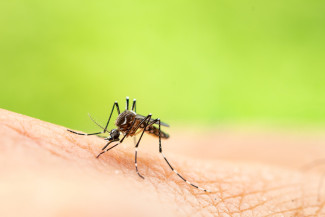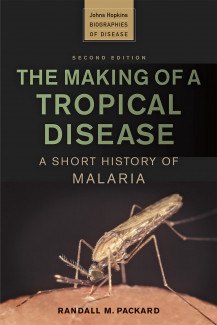
Johns Hopkins UniversityEst. 1876
America’s First Research University
The Making of "The Making of a Tropical Disease" – The Sequel

I was approached by my editor at the Johns Hopkins University Press about preparing a revised second edition of my book The Making of a Tropical Disease: A Short History of Malaria. The book was the first volume in the Johns Hopkins Biographies of Disease series edited by Charles Rosenberg. My editor told me that the Press was interested in publishing a second edition because the first edition had sold well and been widely adopted for course use. That was nice to hear.
But it was not the vision of more royalty checks trickling in that piqued my interest in producing a second edition. It was the realization that the first edition was now badly out of date. It had, in fact, been out of date from the moment it was published.
Any book on the history of a disease that continues to affect millions of people is going to have a short shelf life. Medical knowledge and the epidemiology of diseases can change rapidly. Imagine publishing a history of coronaviruses in the fall of 2019. But The Making of a Tropical Disease, which appeared in the fall of 2007, had a particularly short shelf life.
On October 17, 2007, Bill and Melinda Gates convened a Malaria Forum in Seattle. The meeting was attended by African ministers of health, representatives of major nongovernmental organizations (NGOs), private industries, foundations, and the heads of UNICEF, WHO, and the World Bank.
Melinda Gates kicked off the Forum with a welcoming speech in which she stated, “Bill and I believe that…advances in science and medicine, your promising research, and the rising concern of people around the world represent a historic opportunity not just to treat malaria or to control it—but to chart a long-term course to eradicate it.”
Many at the forum were understandably skeptical. They knew that malaria eradication represented a very high bar to clear. Many also remembered the failed earlier attempt to eradicate malaria in the 1950s and 60s and how the failure had set back efforts to control the disease for years. There were innumerable obstacles in the way. How could the eradication of malaria be achieved when the world of global health was still chasing the last cases of polio, more than thirty years after eradication had been declared the goal by the WHO? Polio was a much easier target for eradication, with a highly effective vaccine.
Yet many, perhaps caught up in the enthusiasm of the moment, were willing to take on the challenge. Most prominently, Dr. Margaret Chan, director-general of WHO, committed WHO to the goal of eradicating malaria and challenged the rest of the world to join her. For many of those who responded positively, setting eradication as the goal of malaria control efforts created an opportunity to consolidate gains that had been achieved since 2000 and to stimulate new commitments to battling malaria. More importantly, it provided an opportunity to sustain momentum going forward.

Support for eradication grew over the following year and the goal of global eradication became the official policy of Roll Back Malaria and WHO with the publication of The Global Malaria Action Plan in 2008. The plan embraced the goal of malaria eradication for the first time.
It is too early to predict whether the world will achieve the goal of malaria eradication. But a great deal has been achieved. To begin with, the call for eradication unleashed massive new funding to support malaria control and elimination activities. Annual global funding for malaria control grew from $1 billion in 2006 to $2.6 billion in 2013. Millions of dollars have been spent on developing new biotechnologies to combat malaria-- antimalarials, long lasting insecticide treated bed nets, rapid diagnostic tests, vaccines, and genetically modified mosquitoes.
The combination of a renewed commitment, increased funding, and technological developments contributed to significant declines in malaria mortality across the globe, particularly in sub-Saharan Africa, where 94 percent of all malaria deaths occurred. According to WHO, the malaria death rate per 1,000 worldwide dropped from 16.6 to 10.2 between 2010 and 2018. The death rate in Africa, fell from 71.9 to 41.0 per 1,000, and in Southeast Asia, from 2.6 to 0.7. Moreover, sixteen countries achieved malaria elimination between 2007 and 2020. Twenty-four countries went from being malaria-endemic countries in 2010 to having fewer than 10 cases in 2018. In addition to individual countries, consortia of geographically contiguous countries were working toward regional elimination of malaria in southern Africa, Mesoamerica, and the Greater Mekong Subregion. The map of malaria was clearly shrinking.
This this is a great story, right?
It is. But unfortunately, there is no mention of these developments in the first edition of The Making of a Tropical Disease. Zippo. So, there was a real need for an updated edition which describes, and equally importantly, examines critically, these developments and what they have and have not achieved. To do this I have revised earlier parts of the book. But most importantly, I have added an extensive new chapter that traces the history of malaria eradication efforts from 2007 to 2020.
While the book has been updated, the central argument remains. Expanded funding, investments in research and the use of new technologies have greatly reduced the global burden of malaria. Yet eliminating malaria will also require efforts to address the social forces that have historically driven malaria, including civil wars and population movements that disrupt malaria control programs, poverty that puts people at risk of malaria infection and prevents both individuals and nations from preventing the disease, and understaffed and poorly funded health services that are unable to identify and treat cases of the disease in a timely manner. History has shown that there are no short cuts for eliminating malaria.
So those of you who want to read a more complete short history of malaria, take a look at the second edition. Of course, I cannot promise you that malaria will not be eradicated in the next few years, making the second edition out of date. I guess I had better get started on a third edition.
Order the second edition of The Making of a Tropical Disease: A Short History of Malaria at the following link: https://jhupbooks.press.jhu.edu/title/making-tropical-disease
Randall M. Packard is a professor of the history of medicine at Johns Hopkins University. He is the author of The Making of a Tropical Disease: A Short History of Malaria, White Plague, Black Labor: Tuberculosis and the Political Economy of Health and Disease in South Africa, and A History of Global Health: Interventions into the Lives of other Peoples.



